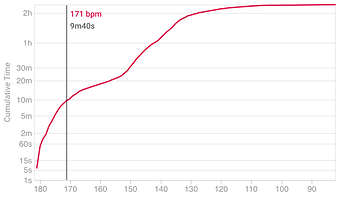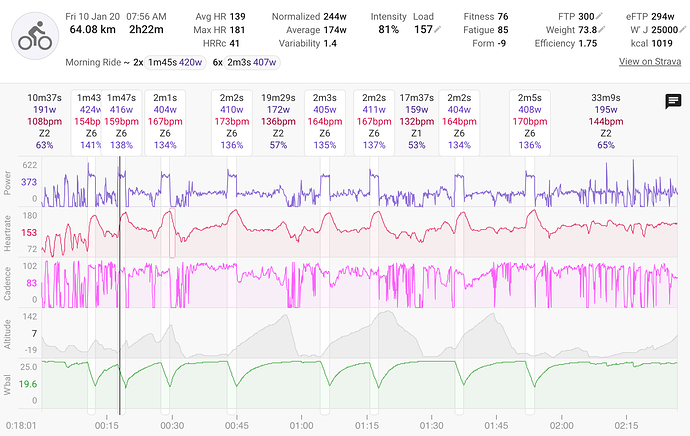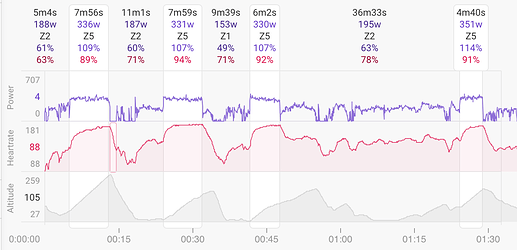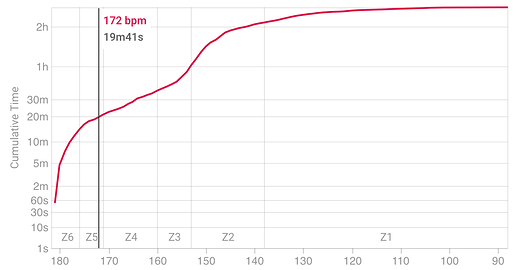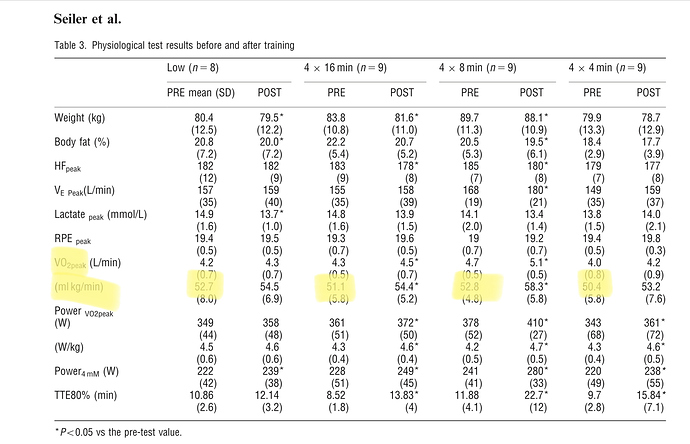I will do one of those sets on Wed. Which is better? My goal is a race not this Sun but the next. It starts almost immediately with a 12 minute climb which I need to do 115% (maybe 120% or more) for 3 minutes, then 110% for next 9 mins or so. If I can do that I might make the 1st bunch chasing the inevitable break and have a good race. I have been doing the 8m intervals for last 3 weeks with good results. In the past I have done shorter 8x2 or 7x3 intervals for vo2 max.
I would probably do 5x 3m at ~120-130% but you should stick to what you feel works for you…
(I had to wait to be able to post my answer)
That’s an interesting question.
My take would be to do the one that resembles the race most closely. The 2 x 8min would drive your W’ down more than the 8 x 2min but dependent on the duration of your recovery between intervals  you may experience equal recoveries.
you may experience equal recoveries.
The research says to improve VO2 max, shorter intervals are better https://joefrielsblog.com/high-intensity-interval-duration/
However, specificity trumps everything. You know you need to do 120% for 3 minutes, followed by 110% for 8 minutes. So that is what you need to train 3 minutes at 120%, followed by 8 minutes at 110% recover, repeat twice more.
gotta love being fast over fifty 
Tx for that article. As it turned out my legs were so knackered I immediately realised that vo2 max wasn’t happening and just did one 8m @103% and rest of 2h ride mostly in Z2 and took a rest day yesterday. The TSB (form) thing doesn’t always work out. According to that I should have been able to go hard 
I am going to be making the fitness and fatigue factors for the fitness chart configurable soon. Maybe at 48 I need longer recovery!
Going to see if I can do the 2m intervals today.
It will only get better - trust me, I’m turning 60 soon 
Found this on the TrainerRoad forums: How Long Should Intervals Be To Maximize Threshold Power?
This study demonstrates that a 4×8 minute interval format induces greater performance enhancement in a group of recreational cyclists when compared to 4×16 minute “threshold training” or 4×4 minute “VO2 max training”.
Nevertheless, it appears that a working intensity of about 90% of maximum heart rate allows for a beneficial combination of sufficiently high intensity and long total duration of work.
So maybe I should dial it back a bit and go for 4 x 8m? ![]()
Phew got em done. First couple a bit short (ran out of hill) but I did more power and the rest were a bit longer. The 2 x 8m give more time at above threshold HR than the 8 x 2m.
This study demonstrates that a 4×8 minute interval format induces greater performance enhancement in a group of recreational cyclists
The operative work here is recreational cyclists. Going on the VO2max figures quoted probably have not done a lot of structured training. The 4x8 minute intervals over 7 weeks gave then the biggest improvement.
However the review also compared to the 30/15 interval study that was tested over 10 weeks on competitive cyclists and given their VO2max averages, had done considerable structured training and at least CAT 3 if not higher.
The conclusion I would draw is medium intervals aka 8 minutes for those starting out structured training a bigger gains and shorter intervals 30/15 seconds are better for riders with structured training experience.
ps given the FTP quoted, you belong in the second category.
I need to look at trying 30/15s. What I did test recently is doing the “hard start” thing (first 30s to 60s or so at 120%). That got me more time at above threshold HR without losing much power. Did it for intervals 2 and 3 here.
Have a listen to this podcast about VO2 max intervals.
One of the things that interested me was that 30/30 protocol increase VO2 max but aren’t as glycolitic as the longer intervals
Hello, I don’t understand the glycolytic stuff. The glycolytic pathway if for sprints and short bouts, so the shortest intervals use it and stimulate its growth as far as I have understood INSCYD stuff and VLaMax
In the Seiler study athletes have a VO2Max around 50 not so bad for people around 40
Also the Ronnestad protocol has been compared to 4x5min intervals ending up not comparing same workload down the road…
I don’t understand it either really. I was just quoting from the podcast from someone who seems to have devoted his life to understanding it. My first thoughts were that it might be that as the durations are short followed by rest intrevals lactate doesn’t have time to really build up in your blood.
Hello, thank you for underlining this stuff because there is something to learn here !
In the last six months, I have listened and read about VLaMax and lowering glycolytic capacity in order to maximise my endurance as long distance triathlete (cf INSCYD theories). So far I have understood that short efforts stimulates the glycolytic pathway (glucose->lactate without O2) Then after producing a good amount of lactate, your body uses it so it relies less on fat oxidation. That’s why it is not a good idea to sprint for the next road sign or to burst climb up a hill when you are riding with budddies with the goal of a long slow distance ride. That’s also why I was more inclined to do “seiler” 4x8 min intervals in the beginning of 2020 to be in line with this idea of avoid the stimulation and growth of VLaMax with short bursts of efforts. So listening to Larsens’ podcast, I guess I might be on a wrong way.
So I listened to the podcast and around 27:00 Dr Larsen says that the short intervals do not rely that much on the glycolytic pathway. He says it but I don’t understand why. He underlines that lactate doesn’t build up in the blood but there might be a lot of lactate in the muscle which enters the citric cycle afterwards. And maybe the rest intervals gives time to “eat” this lactate so that it doesn’t escape that much in the blood to be metabolized in the liver or elsewhere, hence the 4 mmol/l lactate. But to me it’s not a proof of a low usage of the glycolytic pathway. I will have to buy its book !!
The more I think about it, I think 8 min intervals might be great to boost VO2max during a first block of the season, then approaching to the race I should focus more on tempo/threshold training to decrease VLaMax. It’s an idea, gonna dig this.
it seems that it is the shortest HIIT intervals which rely a lot on myoglobin that stimulates less the glycolytic pathway. So maybe doing 15-15 is a way to work on aerobic and neuromuscular compartments without stimulating too much VLaMax growth
[
High-intensity Interval Training, Solutions to the Programming Puzzle. Part II: Anaerobic Energy, Neuromuscular Load and Practical Applications](https://pubmed.ncbi.nlm.nih.gov/23832851/)
Sports Med. 2013 Oct;43(10):927-54.doi: 10.1007/s40279-013-0066-5.
Have you seen the price of his book? ![]()
yup ! I have found explanations on You Tube videos and scientific articles.
To minimize glycolytic contribution, I imagine doing 30/30 with a raisonnable goal of 100% MAP on the intervals. This way you have some kind of stimulus of VO2max without too much strain on the glycolytic pathway. It’s what I have understood from their classification of HIIT workouts.


